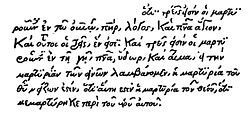- Codex Montfortianus
-
New Testament manuscripts
papyri • uncials • minuscules • lectionariesMinuscule 61
Comma JohanneumName Codex Montfortianus Text New Testament Date c. 1520 Script Greek Now at Trinity College, Dublin Size 15.8 cm by 12 cm Type mixed, Byzantine text-type (Gospels, Acts) Category III, V Note marginalia Codex Montfortianus designated by 61 (on the list Gregory-Aland; Soden's δ 603),[1] and known as minuscule 61, Erasmus named it Codex Britannicus, is a Greek minuscule manuscript of the New Testament on paper. It is dated to the early 16th century, though a 15th century date is possible on palaeographic grounds.[2] The manuscript is famous for the Comma Johanneum. It has marginalia.
Contents
Description
The codex contains the entire of the New Testament. The text is written in one column per page, 21 lines per page, on 455 paper leaves (15.8 cm by 12 cm).[3]
The text is divided according to the κεφαλαια (chapters), whose numbers are given at the margin, and their τιτλοι (titles) at the top of the pages. There is also another division according to the smaller Ammonian Sections, with references to the Eusebian Canons.[4]
It contains prolegomena, tables of the κεφαλαια (tables of contents) before each book, and subscriptions at the end of each book, with numbers of στιχοι. The titles of the sacred books were written in red ink.[4]
The order of books: Gospels, Pauline epistles, Acts, General epistles (James, Jude, 1-2 Peter, 1-3 John), and Book of Revelation.[4] The order of General epistles is the same as in Minuscule 326.
Text
The Greek text of the Gospels and Acts of this codex is a representative of the Byzantine text-type, Aland placed it in Category V. In Pauline epistles and General epistles its text is mixed. Aland placed it in Category III.[5] In the Book of Revelation its text belongs to the Byzantine text-type but with a large number of unique textual variants, in a close relationship to the Uncial 046, and Minuscule 69.[6] In the Gospels close to the manuscripts 56, 58. It was not examined by the Claremont Profile Method.[7]
In 1 John 5:6 it has textual variant δι' ὕδατος καὶ αἵματος καὶ πνεύματος ἁγίου (through water and blood and the Holy Spirit) together with the manuscripts: 39, 326, 1837.[8][n 1] Bart D. Ehrman identified this reading as Orthodox corrupt reading.[9]
It contains the Comma Johanneum as an integral part of the text. An engraved facsimile of the relevant page can be seen in Thomas Hartwell Horne, An Introduction to the Critical Study and Knowledge of the Holy Scriptures (London: Cadell and Davies, 1818), vol. 2.2, p. 118.
History
It was the first Greek manuscript discovered that contains the Comma Johanneum in 1 John 5:7-8. It was copied from a 10th century manuscript at Lincoln College, Oxford, that did not have the Comma. The Comma was inserted from the Latin.[10] Its earliest known owner was Froy, a Franciscan friar, then Thomas Clement (1569), then William Chark (1582), then Thomas Montfort, from whom it derives its present name, then Archbishop Ussher, who caused the collation to be made which appears in Walton's Polyglott (Matthew 1:1; Acts 22:29; Romans 1), and presented the manuscript to Trinity College.[11][2]
This codex was used by Erasmus in his third edition of Novum Testamentum (1522).[2] Erasmus misprinted εμαις for εν αις in Apocalypse 2:13.[2]
It was described by Wettstein[12] and Orlando Dobbin. C. R. Gregory saw it in 1883.[4]
The codex now is located at Trinity College (Ms. 30) in Dublin.[3]
See also
Notes
- ^ For the another variants of this verse see: Textual variants in the First Epistle of John.
References
- ^ Gregory, Caspar René (1908). Die griechischen Handschriften des Neuen Testament. Leipzig: J. C. Hinrichs'sche Buchhandlung. p. 50. http://www.archive.org/stream/diegriechischen00greggoog#page/n61/mode/2up.
- ^ a b c d Scrivener, Frederick Henry Ambrose; Edward Miller (1894). A Plain Introduction to the Criticism of the New Testament. 1 (4 ed.). London: George Bell & Sons. p. 200.
- ^ a b K. Aland, M. Welte, B. Köster, K. Junack, Kurzgefasste Liste der griechischen Handschriften des Neues Testaments, Walter de Gruyter, Berlin, New York 1994, p. 50.
- ^ a b c d Gregory, Caspar René (1900). Textkritik des Neuen Testaments. 1. Leipzig: Hinrichs. pp. 142–143. http://www.archive.org/stream/textkritikdesne00greggoog#page/n155/mode/2up.
- ^ Aland, Kurt; Barbara Aland; Erroll F. Rhodes (trans.) (1995). The Text of the New Testament: An Introduction to the Critical Editions and to the Theory and Practice of Modern Textual Criticism. Grand Rapids: William B. Eerdmans Publishing Company. p. 129. ISBN 978-0-8028-4098-1.
- ^ Bruce M. Metzger, Bart D. Ehrman, The Text of the New Testament: Its Transmission, Corruption and Restoration, (Oxford University Press, 2005), p. 86.
- ^ Wisse, Frederik (1982). The profile method for the classification and evaluation of manuscript evidence, as Applied to the Continuous Greek Text of the Gospel of Luke. Grand Rapids: William B. Eerdmans Publishing Company. p. 54. ISBN 0-8028-1918-4.
- ^ UBS3, p. 823.
- ^ Bart D. Ehrman, The Orthodox Corruption of Scripture, Oxford University Press, Oxford 1993, p. 60.
- ^ Bruce M. Metzger, Bart D. Ehrman, The Text of the New Testament: Its Transmission, Corruption and Restoration, (Oxford University Press, 2005), p. 88, 147.
- ^ S. P. Tregelles, "An Introduction to the Critical study and Knowledge of the Holy Scriptures", London 1856, p. 213-14.
- ^ Wettstein, J. J. (1751). Novum Testamentum Graecum editionis receptae cum lectionibus variantibus codicum manuscripts. Amsterdam: Ex Officina Dommeriana. p. 52. http://www.archive.org/stream/hekainediatheken00clem#page/52/mode/2up.
Further readings
- Dobbin, Orlando T. (1854). The Codex Montfortianus, a Collation of this Celebrated MS ... throughout the Gospels and Acts with the Greek and Acts with the Greek Text of Western and with certain MSS (Evv 56, 58, Ag 33) in the University of Oxford. London: Samuel Bagster and Sons. http://books.google.pl/books?id=ZVM7Drma5ZwC&pg=PP7&dq#v=onepage&q=&f=false.
External links
- Codex Montfortianus at the Encyclopedia of Textual Criticism
- Johannum Comma Archives
Categories:- Greek New Testament minuscules
- 16th-century biblical manuscripts
Wikimedia Foundation. 2010.

